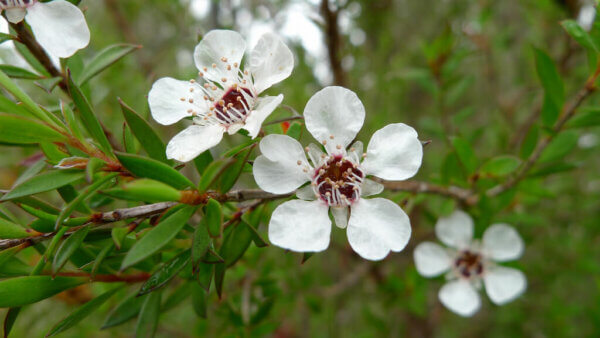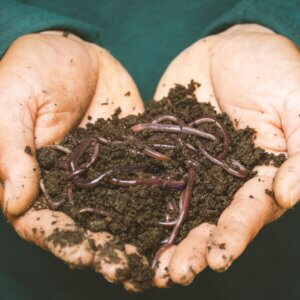A few weeks ago we noticed a rash on my little nephew’s foot. One look at his foot and I knew it was ringworm.
Ringworm can be recognized by the round, worm-shaped rash. The area is usually red and the worm-like fungi are somewhat raised and bumpy. Sometimes it can be dry and scaly.
I had everything I needed to make him some homemade antifungal cream, so I whipped up a quick batch. We applied the cream two times a day, and in two weeks the ringworm was gone! The great thing about this cream is it can be used to treat many fungal infections including athlete’s foot.
What Is Ringworm And Is It Really A Worm?
Ringworm has absolutely nothing to do with worms in any way, shape, or form. Despite the name of the infection being ringworm, the culprit is actually a group of fungi called dermatophytes that can cause infections. The infection earned the nickname “ringworm” due to the worm-like ring pattern it causes on the skin.

The technical medical name for ringworm is tinea. The infection can take place anywhere on the body, but the skin disease is named further depending on the location.
For instance, Tinea pedis is the medical terminology for athlete’s foot, the same type of fungal infection as the ringworm, only on a different part of the body. The area of the body that’s affected by the infection is what produces a different physical effect. Athlete’s foot is itchy like ringworm, but you won’t find any worm-like raised bumps.
Signs And Symptoms
Ringworm is highly contagious and can spread rather quickly in the right environment. Be sure to wash clothes, bedding, and anything the person may have had the affected area on.
Here are some common signs to look for:
- Red patches on the scalp or body
- Round, blister-like lesions
- Scaly, crusty rash in the shape of a worm
- Possible hair loss – on scalp especially
- Itchy, red, irritated skin
The Ingredients And How They Work
Before I continue I would like to add that if using essential oils is new to you or an essential oil itself is new to you or your children, always do a tiny spot test to see if there is any negative reaction.
You will be able to tell rather quickly as the skin will become red and irritated. If this happens, wash off the oil and dry the spot to remove the oil. Essential oils can have different effects on different people just like anything else.
Jojoba Oil (Simmondsia chinensis)
Jojoba oil makes a great healing oil, as well as a carrier oil, especially for sensitive skin. The oil is high in iodine which helps fight infection and it’s loaded with vitamins and nutrients as well.
Vitamin E, zinc, chromium, B-complex, and so many more. Myristic acid contains natural anti-inflammatory properties and is also present in jojoba oil. On top of all that greatness, jojoba oil enhances the absorption of topical drugs, in this case, the healing oils.
As a note, another great carrier oil is avocado oil, especially since many people already have it readily available in their pantry!
Tea Tree Oil (Melaleuca alternifolia)
Tea tree oil is one of my favorite essential oils when it comes to healing. Tea tree contains natural antiseptic, anti-inflammatory, and antibacterial healing properties. The essential oil has been incorporated as an active ingredient in several topical treatments for cutaneous infections.
Tea tree oil is a very potent and very powerful volatile oil so use it carefully. The antibacterial properties are amazing, and the activity of tea tree oil against antibiotic-resistant bacteria has many medical professionals and healers interested in the many uses.
On top of all that healing, add some antifungal and antiviral healing properties that reduce the growth activity of bacteria and fungi. PERFECT for killing that pesky ringworm!
Lavender (Lavandula angustifolia and officinalis)
Lavender is well-known for the aromatic scent often used in many things aromatherapy. This is because it is calming and relaxing when inhaled. This sweet plant actually helps ease pain too!
Lavender naturally fights antifungal-resistant strains of infections. The antimicrobial properties help protect the body from harmful microorganisms.
This makes it great for topical skin infections. And the lovely smell is just an added bonus!
Virgin Coconut Oil (Solid)
Coconut oil is naturally moisturizing. The natural barrier repair and antibacterial properties make coconut oil a nice addition to finish off the cream.
Without the coconut oil, your recipe would simply be an antifungal oil which isn’t bad, it’s just nice to have the added benefits and the extra carrier oil for sensitive skin.
Antifungal Cream Recipe
Ringworm, athlete’s foot, and any other type of fungal infection that affects the skin can be terrible. This DIY recipe is easy to make and effective too! You can use this for any type of bacterial or fungal infection of the skin.
Always be sure to do your own research before trying anything new to you. I’m not a doctor, nor do I claim to be one. This is just a healing method that has worked for me and my newphew, and I hope it works well for you!
Ingredients
- 80 drops jojoba oil
- 8 drops tea tree oil
- 10 drops lavender essential oil
- Virgin coconut oil – enough to make a paste
Directions
- Simply spoon out some of the coconut oil into a bowl, add the essential oils one at a time, and mix it thoroughly.
- I transfer my cream from my glass mixing bowl into a stainless steel canister of an appropriate size.
Instructions For Use
- Wash the affected area with warm soapy water. It’s best to allow the area to air dry, but if that’s not possible, just use a clean towel and gently pat it dry.
- Now simply rub enough of the cream onto the infected area to coat it lightly. I think it’s a good idea to rub some of the cream around the outside of the affected area to help avoid any spreading.
Try to leave the area uncovered while the cream is on working its magic. My little nephew’s spot was on his foot, so after we’d apply an application we just left his socks and shoes off for at least 15 minutes to a half an hour.

Applying it right before bed is a good idea, too. Use the cream two to three times a day until all signs of the ringworm are gone. It should only take about two weeks for it to clear up. The larger the area, the longer it might take to see results.











































Leave a Reply